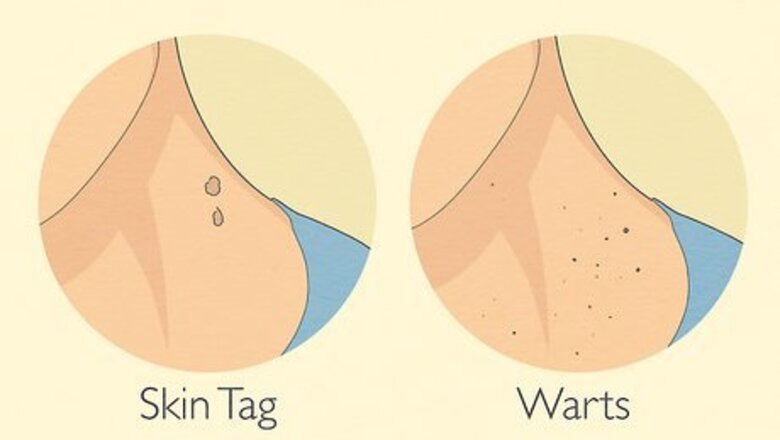
views
X
Trustworthy Source
National Health Service (UK)
Public healthcare system of the UK
Go to source
This wikiHow article will teach you the safest home remedies and best over-the-counter products for getting rid of skin tags at home. We'll also give you helpful information on the medical procedures that doctors use to painlessly remove skin tags.
- Always consult with a doctor or medical professional before trying to remove skin tags at home.
- Over-the-counter skin tag and wart freeze-off products may be effective, and you can find them at most pharmacies.
- Doctors remove skin tags safely, quickly, and painlessly using cryosurgery (freezing), surgical excision (cutting), or cauterization (burning).
Home Remedies
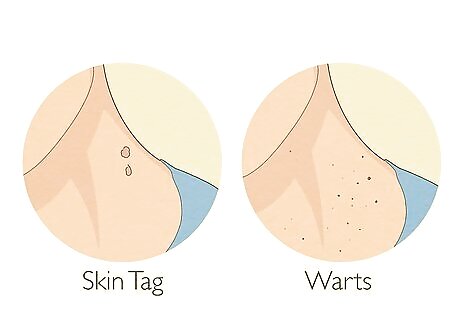
Make sure your growth is a skin tag before trying any home remedies. Always consult with a doctor or medical professional before trying to remove skin tags at home, even if you really believe your growth is a skin tag. Skin tags can be confused with other skin lesions, including neurofibromas, seborrheic keratosis, viral warts, and even skin cancer—none of which can be safely removed at home. Since skin tags have a strong and constant blood supply, you're likely to experience bleeding if you try to remove them at home. Sometimes a wart can look like a skin tag and vice versa. To differentiate the two, notice that a skin tag has a smoother surface, hangs away from the primary skin, and is not contagious. Never attempt to remove a skin tag from your eye or genitals at home.
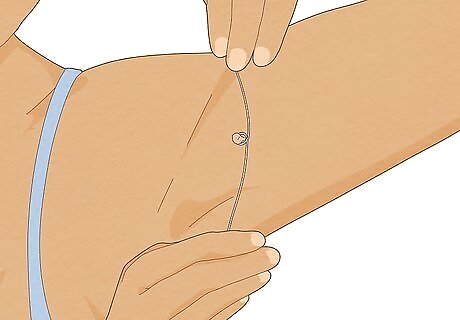
Tie off the skin tag at the base. If your skin tag is small and has a narrow base, you may be able to get rid of it by tying it off with dental floss or thin cotton string. This ligation technique will cut off the blood supply to the skin tag, eventually causing it to fall off. Tie the string around the base of your skin tag and tighten the tie until it is firm, but not painful. Snip off the excess and leave the string in place for a few days. After a few days, the skin tag will turn dark in color, and then fall off. Be careful when using this method. If your skin tag is too large to be tied off, or if you tie off too close to the largest part of the growth or the base of your skin, you could wind up with an infection. If you experience pain or smell a bad odor from the skin tag, remove the tie and consult with your doctor.

Apply tea tree oil. While there's no scientific evidence that tea tree oil will remove a skin tag, studies do support this essential oil's ability to dry up pimples and other skin conditions. Because tea tree oil dehydrates the skin, it may also dry up your skin tags over time. While most tea tree oil products in stores are specifically made for skin, always dilute full-strength tea tree essential oil with a vegetable or nut carrier oil (e.g., almond oil, coconut oil, grapeseed oil) at a rate of 3 drops of essential oil to 1 tsp (4.93 mL) of oil before applying topically. To use this remedy: Apply tea tree oil to a clean cotton ball. Place the cotton ball onto the skin tag and secure with a bandage and leave the bandage in place overnight. In the morning, remove the bandage and wash the area thoroughly. Repeat nightly until the skin tag falls off. Avoid using tea tree oil if you have eczema or if the skin tag is near your eye.

Use apple cider vinegar. Similar to using tea tree oil, apple cider vinegar may be able to dry the skin tag out enough for it to fall off on its own. Soak a cotton ball in apple cider vinegar, place it on the skin tag, and bandage it in place for about 10 minutes. Repeat this process 3 times per day. Support for this method is largely anecdotal, as there have been no scientific studies on using apple cider vinegar on skin tags. Never use apple cider vinegar around your eyes or on broken skin. Apple cider vinegar can irritate the skin and even lead to skin ulcers. Discontinue treatment if you notice redness, irritation, or itching. Apple cider vinegar may also benefit acne.
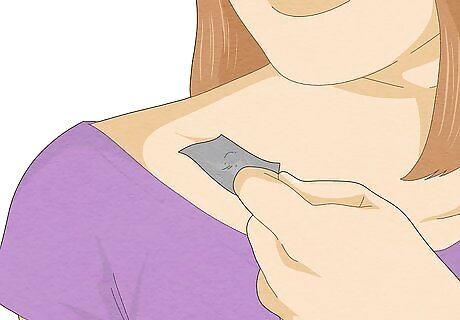
Cover the skin tag with duct tape or moleskin. While there haven't been studies on the effectiveness of duct tape or moleskin on skin tags, some studies have shown positive results in getting rid of warts with duct tape. The adhesive on tape and moleskin could be irritating and may cause pain during removal, so keep that in mind. Cut out a small square of duct tape or moleskin around 1” in diameter. Place this square right on top of your skin tag. Leaving the tape or moleskin on may gradually dry the tag out until it falls off. You can replace with fresh tape each day. This method supposedly works within 10 days.
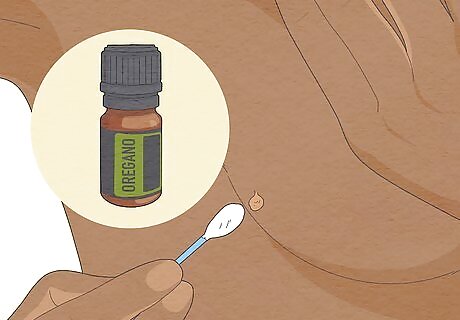
Dab on some diluted oregano oil. Oil from the oregano plant has been used for centuries as a folk remedy for skin conditions. But because this essential oil is very strong, you'll need to dilute it in a carrier oil before applying it to your skin. Combine 1 drop of oregano oil with 1 tsp (4.93 mL) of a vegetable or nut oil like olive oil, coconut oil, or almond oil, before application. Apply five to six drops of the mixture to a clean cotton swab, and apply it on your skin tag three times a day. You should see the tag gradually dry up after a month. Never use essential oils, including oregano oil, around your eyes. If your skin appears red during treatment, stop using the oil. You should also avoid treating the area around your eyes.
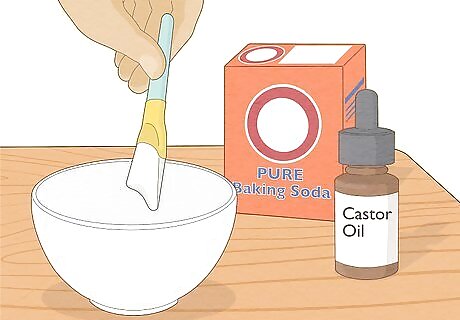
Mix baking soda and castor oil. While there's no scientific proof that this combination will definitely get rid of skin tags, some integrative health practitioners recommend applying a mix of castor oil and baking soda to the skin tag. You'll want to apply the mixture 3 times per day until the skin tag falls off.
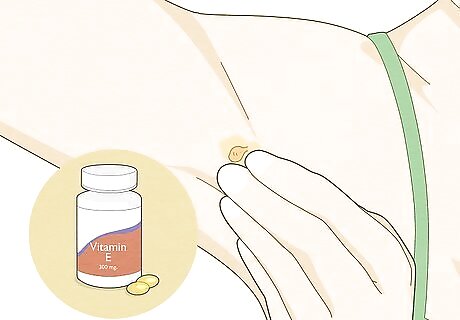
Massage the skin tag with vitamin E oil. Vitamin E is a powerful antioxidant used in dermatology for many skin issues, including dermatitis, scar healing, and melasma. If you have vitamin E in the form of gel caps at home, you can cut open a gel cap and massage the oil onto the skin tag. If not, you can buy vitamin E oil at any natural grocer, as well as online. Apply vitamin E oil to the skin tag once per day until it falls off.

Other natural options. Many naturopaths and integrative health practitioners recommend natural remedies for skin tag removal. Just keep in mind that some of these substances could irritate the skin—be sure to discontinue treatment if you experience pain, redness, or itching. Dandelion stem juice: Get a fresh dandelion and squeeze the stem from the bottom to the top until the juice comes out. Apply three drops of dandelion juice to the skin tag every day, and repeat for up to 4 weeks until the skin tag falls off. Lemon juice: Lemon juice is highly acidic, which makes it excellent for antiseptic use. Squeeze fresh lemon juice into a bowl. Dip a cotton ball into the bowl. Place the ball onto the skin tag. Repeat up to three times a day. Pineapple juice: You can buy pineapple juice at a store or make it at home. Dip a cotton ball into the juice and apply it to your skin tag. You can apply this up to three times per day. In a week or so you may notice your skin tag starting to dissolve away.

Cut off the skin tag (if it's small enough). In most cases, your doctor will not recommend or support cutting off a skin tag yourself. Cutting off a skin tag at home can cause heavy bleeding, infections, and permanent scarring. However, if your skin tag is very small, protruding away from your body, and has a narrow base, you may be able to cut it off at home using a sterilized pair of sharp scissors. If the skin tag is on your neck or in another hard-to-reach area, ask a trusted friend or family member to help you remove it. Or, better yet, consult a professional. Sterilize your scissors, along with some tweezers that you'll use to hold the skin tag away from the skin. You can use any sharp scissors, including cuticle nippers, as long as they're sterilized with hospital-grade disinfectant or 80% isopropyl alcohol. Snip the stem of the skin tag. Clean your skin well with soap and water, then pat it dry. If you're worried about pain, you can use an ice cube to numb your skin.
Over the Counter Products

Skin tag or wart freezing kits. Over-the-counter freezing kits use cryotherapy to freeze the growths, which eventually causes them to fall off on their own. If possible, try to find a freezing kit specifically made for removing skin tags, such as Dr. Scholl's Skin Tag Remover, Cryotag, or Compound Skin Tag Remover. But because wart freeze-off kits use the same formula (typically propane and isobutane), a wart-specific kit will also get rid of skin tags. Only use a freeze-off kit if the skin tag is soft, pliable, flesh-colored, and on your neck, chest, underarm, back, or groin. Avoid over-the-counter skin tag freezing products if you have diabetes, any type of skin cancer, or precancerous lesions. Make sure you follow the box directions carefully as you can potentially damage the skin around the tag perhaps even causing scarring and discoloration.

Banding (ligation) kits. Like tying it off with floss, you can use a banding kit to cut off the skin tag's blood supply at the base, which eventually causes the growth to fall off. To use a kit like TagBand or ProVent, you'll simply place the included device over your skin tag, and either twist or press a button to wrap the skin tag tightly with a silicone band. Skin tag banding kits may be rated for different size skin tags. Before purchasing a skin tag remover that works by banding the skin tag, check the packaging to make sure it will work for your skin tag.

Removal creams and patches. Over-the-counter creams, ointments, and patches aimed toward skin tag removal often contain salicylic acid, tea tree oil, and other strong essential oils and drying agents. Most of these solutions claim to be able to get rid of skin tags in 2 to 3 weeks of constant application. These ingredients may cause contact dermatitis. If the area surrounding your skin tag becomes irritated, stop using the cream or patch at once.
Medical Procedures
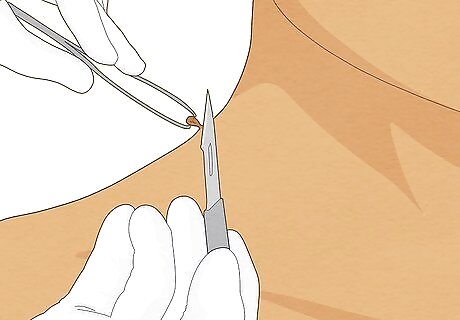
Surgical excision (cutting or shaving). Depending on the size and location of your skin tag, your doctor might be able to cut or shave it off. Your doctor will numb your skin to prevent pain, and then use a scalpel or medical scissors to cut the tag away from the base of your skin. Excision is typically the fastest way to remove skin tags, although there might be some bleeding afterward. If your doctor decides on shave excision, they'll use a very sharp blade to shave off the skin tag out of your skin. This is a fast and effective skin tag removal method, and thanks to local anesthesia, you won't feel any pain. To minimize scarring after the skin tag is removed by shaving, the doctor may use a small electrode to "feather" the wound—a procedure called electrosurgical feathering.

Cryosurgical removal (freezing). With cryosurgery (also known as cryotherapy), the doctor will first numb your skin to reduce pain. Then, they'll use a probe to apply a small amount of liquid nitrogen to the site of your skin tag, which will prevent new skin cells from growing. The skin tag will fall off within a few weeks after the procedure. It is common for a blister to form a few hours after cryosurgery, and there may be minor pain for a few days. A scab will form and then fall off on its own within 1 to 3 weeks. Freezing off skin tags may cause hypopigmentation (loss of melanin) in dark skin, leaving a lighter spot in place of the skin tag. If your skin tone is dark and the skin tag is in a prominent location (such as your face), you might want to consider a different removal method.
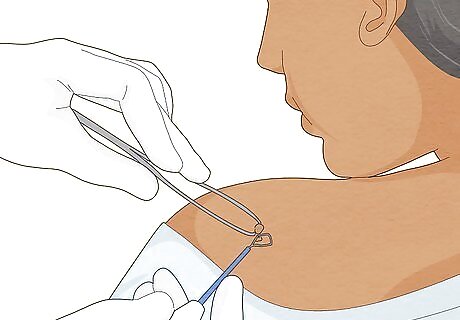
Cauterization (burning it off). With cauterization, your doctor will use a small probe to apply a heat source directly to the surface of the skin tag. The heat provided by the electrical current will burn off the tag resulting in a quick and easy removal. In some cases, the doctor may use an electrical current to burn off the skin tag instead. Cauterization should not be painful, as the doctor will apply a numbing agent to the skin first.




















Comments
0 comment